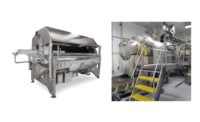The plant-based food market grew almost twice as fast as the total U.S. retail food market in 2020. Sales of plant-based meat, dairy, and eggs increased by 27%, bringing the total plant-based market value to $7 billion, according to data from the Plant-Based Foods Association (PBFA) and The Good Food Institute (GFI).
The largest plant-based category remains milk, but even as the most developed and consumer accepted plant-based food, plant-based milk grew 20% in dollar sales, up from 5% in 2019. This growth is twice as fast as traditional cow’s milk, and 39% of U.S. households now purchase plant-based milk.
While plant-based meat is the second-largest plant-based category, its growth was first among plant-based products, with sales growing 45%. The most significant increase came in refrigerated plant-based meats as sales grew 75% in 2020, with products increasingly shelved adjacent to conventional meat. This placement in the meat section in similar package styles helped propel growth in the segment, with refrigerated plant-based meat sales increasing more than twice as fast as frozen plant-based meat sales. More consumers are identifying plant-based meats as a legitimate alternative to meats.
COVID-19 gave retail sales of plant-based foods an extra boost at a time when interest in the sector was already surging, driven by a focus among consumers on personal health, sustainability, food safety, and animal welfare. According to a report from Mintel, these factors will continue to propel consumption; it notes that 35% of U.S. consumers agree with the statement, “The Covid-19/coronavirus pandemic proves that humans need to eat fewer animals.”
Initially, packaging’s most prominent role for plant-based foods was protection and information. Plant-based options touted as alternatives to meat and dairy typically found their way into packaging structures similar to conventional options. From a marketing perspective, this allowed the products to blend in more with regular options as consumers need to find new options. The labeling and indications on packages made consumers aware of the differences and touted the positive claims of plant-based products. The PDFA’s certified plant-based seal program is the first plant-based food certification, for example, and this label instills confidence in consumers.
Now that plant-based brands have obtained a foothold commercially, better packaging solutions can avoid confusion about product ingredients and environmental benefits while offering a more user-friendly experience. This is particularly true as it pertains to sustainable packaging. Millennials and younger consumers turn to plant-based products to invoke a more sustainable planet. Transitioning to plant-based meat and dairy has environmental benefits, and the natural next step is to include packaging that also reduces the carbon footprint. Some plant-based products are beginning to transition to packages made of monolayer films or in sustainable materials containing polylactic acid. The compostable and recyclable material is growing in use as an environmental-friendly alternative to fossil fuel plastics like polyethylene, polystyrene, and polypropylene. Derived from several different renewable plant-based materials like sugar cane or cornstarch and with characteristics like petrochemical-derived plastics, PLA is resilient, rigid, and UV-light resistant.
While the expanding market for plant-based products is nudging the food industry to use more biodegradable materials such as PLA, the more significant shift towards the material lies in its lesser carbon footprint. The demand for PLA projects to reach $1.7 billion by 2026, with developments underway for large-scale application in rigid containers for yogurt, juice, water, and many other food products in the future. Further, with demand increasing from the flexible packaging sector, original equipment manufacturers (OEMs) of packaging machinery are incorporating the films into new machines and developing retrofits for machinery already in place.
No other East Coast event will offer such a wide range of state-of-the-art packaging and processing solutions as PACK EXPO East (March 21-23, 2022; Pennsylvania Convention Center). With 400 exhibitors, PACK EXPO East provides a convenient and rewarding opportunity for consumer packaged goods (CPG) and life sciences professionals to explore packaging and processing technology, connect with suppliers and find the solutions needed to compete in a changing marketplace conveniently located just a drive or train-trip away for most of the East Coast. To register or learn more, visit packexpoeast.com.




Report Abusive Comment